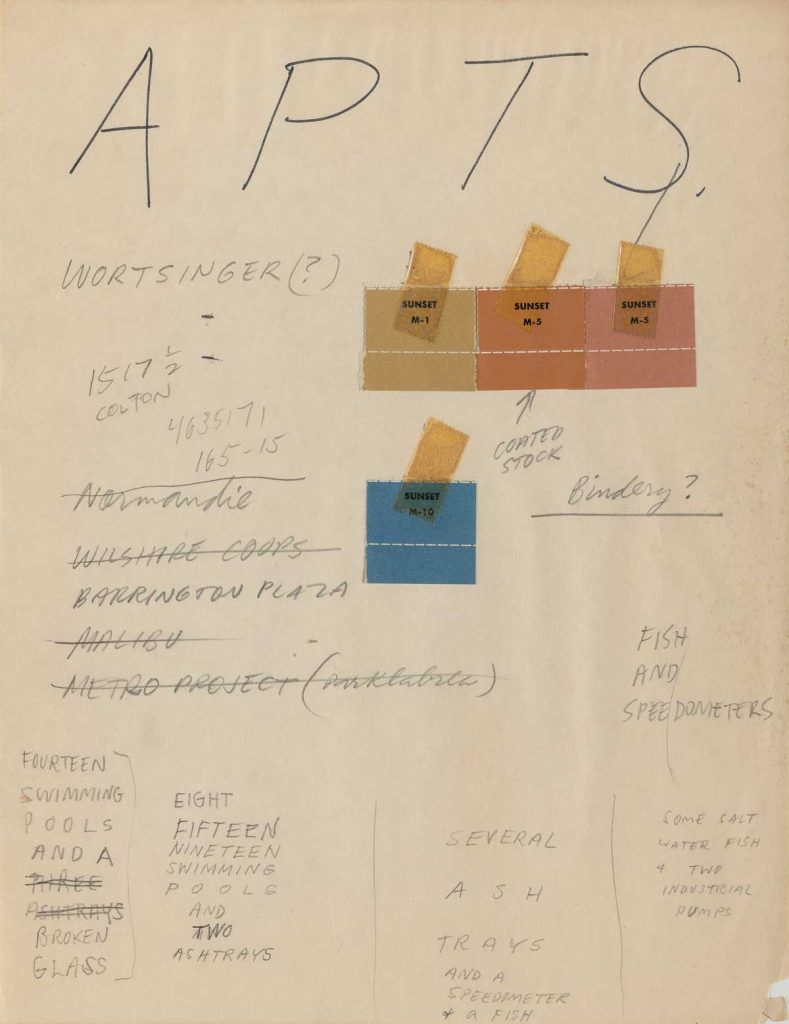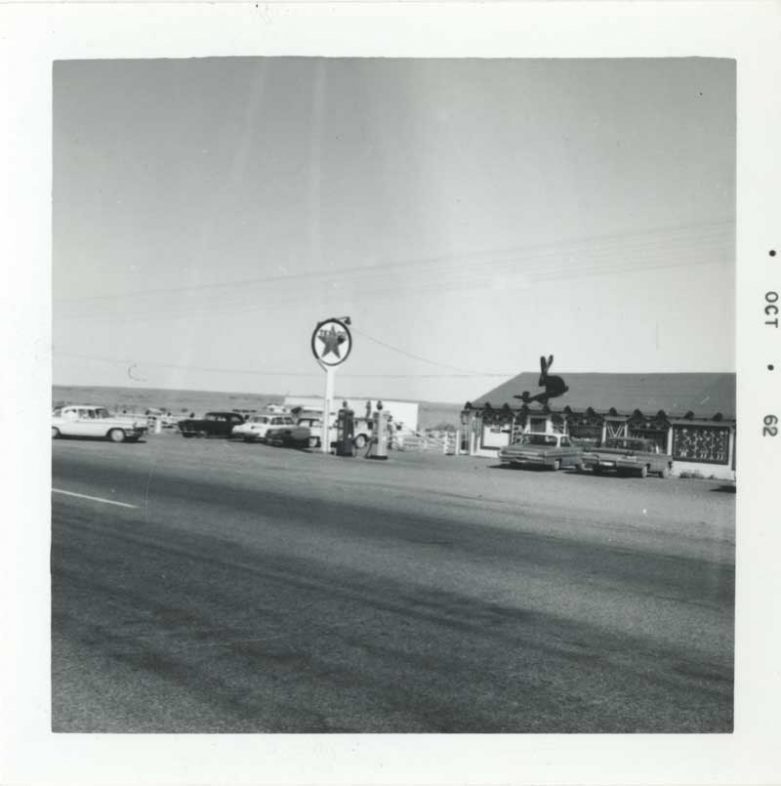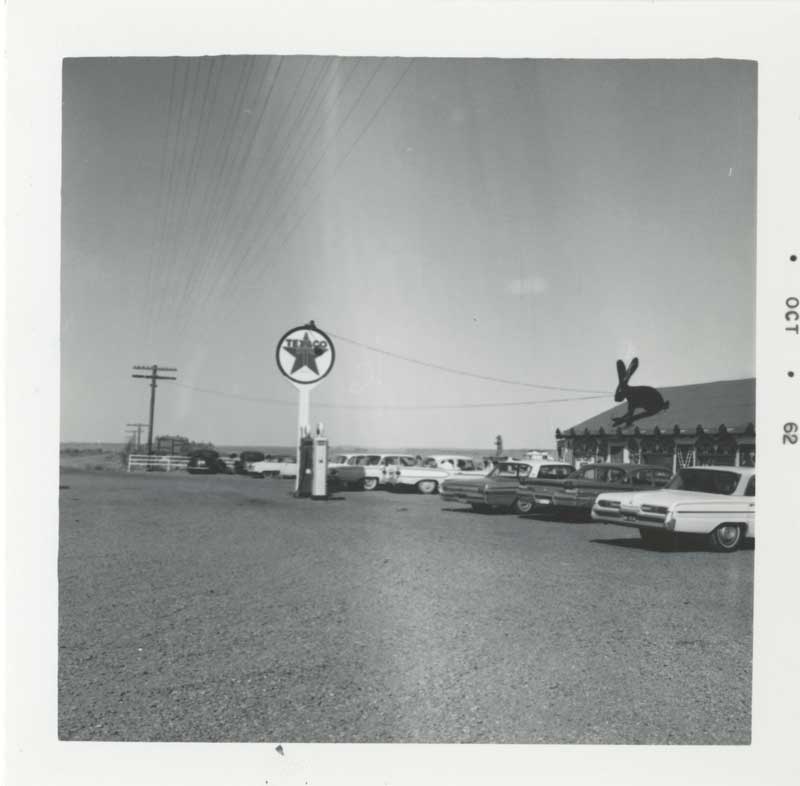Driving along Route 66 in 1962, Ed Ruscha pulled over at the Jack Rabbit Trading Post just outside Joseph City, Arizona. He picked up his camera and made at least two exposures: one at an oblique angle from the narrow parking lot in front, placing the gas pumps and Texaco sign near the center of the frame; and another from across the highway, composing a wider view of the popular tourist stop. In that exposure, the long ears of the trading post’s giant wooden mascot appear in silhouette just above the roofline, and a row of smaller rabbits along the roof’s edge are aligned with the horizon, ready to hop into the desert. Both photographs are intentionally “artless,” as if taken by an anonymous amateur, yet their comparison invites us to imagine the artist moving through the scene.
These views of the Jack Rabbit Trading Post are just two of the photographs Ruscha gathered as potential illustrations for his first artist’s book, Twentysix Gasoline Stations (1963), over the course of several road trips along the same route. He selected one for the book and identified it with the caption Texaco, Jackrabbit, Arizona; he filed the variant away with more “outtakes” in his studio. Both are now preserved at the Ransom Center, alongside other preparatory materials for the 16 books Ruscha published between 1963 and 1978. Manuscripts, printing records, and page layouts in the collection trace the production of those groundbreaking books, and form the core of the exhibition Ed Ruscha: Archaeology and Romance.

After completing Twentysix Gasoline Stations in 1963, Ruscha published an artist’s book each year for the next five years. Despite the appearance of a linear production schedule, Ruscha’s production files make it clear that he actively worked on several projects at once, with many other ideas incubating in notes and sketches. A loose page headed “APTS.,” filed with production material for his book Some Los Angeles Apartments (1965) serves as one lively example. Ruscha adhered color chips in shades of coral and blue—perhaps early contenders for the book’s cover typography—next to a short list of apartment complexes. He filled the remainder of the page with ideas for future book titles, some more absurd than others. One idea, “Fourteen Swimming Pools and a Broken Glass,” closely predicts the title of a book he published three years later, substituting nine pools for the original fourteen.
Nine Swimming Pools and a Broken Glass (1968) was Ruscha’s first book with color photographs, and production records preserved in his papers show that he controlled the printing process with brilliant subtlety. Four layers of ink are customarily used to reproduce a color photograph in print—cyan, magenta, yellow, and black—yet Ruscha’s handwritten printing specifications call for “10 3-COLOR SEPARATIONS (NO BLACK).” Omitting the black layer yielded a cost savings of $1.50 for each photograph in the book, according to a price list for color separations retained in Ruscha’s files; yet other decisions, such as increasing the page count from 48 to 64 in a book with so few photographs, suggest that Ruscha’s priorities were aesthetic rather than budgetary. Printing the photographs in only three colors limited depth and detail in the shadows, leaving the swimming pool scenes with a too-bright, sun-bleached, strangely illusory feel.

Alongside these traces of the process leading up to Ruscha’s landmark publications, Ed Ruscha: Archaeology and Romance explores the ways in which the artist subsequently transformed the motifs introduced in his books into works in other media. The exhibition features a selection of Ruscha’s screenprints and sketches based on the gasoline station motif, drawings informed by his studies of Los Angeles apartments, and a poster he designed for an experimental, multimedia magazine, featuring one of his 34 parking lots. Six lithographs from the series Book Covers (1970), included in the exhibition, show that Ruscha not only engaged the motifs within his books, but also depicted his books as whole objects.
It wasn’t until 1989, however, that Ruscha returned to the photographs that populate the pages of books such as Twentysix Gasoline Stations, and considered presenting them as independent works. In the intervening quarter century, Texaco, Jackrabbit, Arizona and other photographs from the 1960s had been known only in reproduction. That year he produced Gasoline Stations 1962, a portfolio of ten gelatin silver prints from his original negatives. Ruscha has since revisited the photographs made for several of his books, and has created new portfolios and suites of prints. In many cases, these new works allow viewers to see what Ruscha included, left out, or changed in the process of creating his books decades earlier.

The portfolio Pools (1997) gives viewers the opportunity to see Ruscha’s nine swimming pools in full color, and removed from the context of his 1968 book, where they are encountered at unpredictable intervals between blank pages. Parking Lots (1999) offers full-frame versions of aerial views originally cropped and rotated for layout in the book Thirtyfour Parking Lots in Los Angeles (1967). The portfolio Vacant Lots (2003) offers four “outtakes” from the book Real Estate Opportunities (1970), including one in which Ruscha appears in shadow, holding his twin-lens reflex camera above his head to frame an elevated perspective. These subtle traces of the artist and his creative choices appear throughout Ed Ruscha: Archaeology and Romance, and suggest that a great deal remains to be learned from his papers in the Ransom Center collection.
Top: Ed Ruscha (American, b. 1937), “Pool #2,” from the portfolio “Pools,” 1968; printed 1997. Chromogenic color print, 40.4 x 40.7 cm (image). Edward Ruscha Papers and Art Collection, 2013.16.2 © Ed Ruscha.


